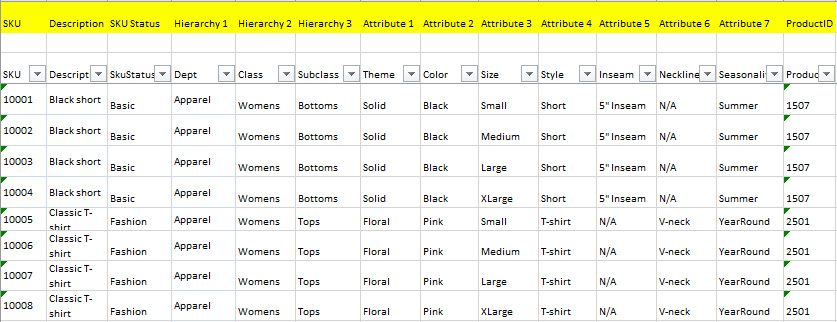Companies have immense amounts of product assortment data and are constantly adding more. It can be a challenge to keep this data organized in a manner that makes analysis accurate and efficient, as well as serve the needs of the different areas of the company. A well-maintained Product Master will enable all departments to get the product information they need to make strategic decisions.
A Product Master is a data management solution that compiles all product-related data into one location. The data that is entered into it is clean, consistent, accurate and complete. The product information can be used by all departments in the company to gain insights so strategic decisions can be made. By having a Product Master, the company can be assured that all departments are using the same data set and that the data is complete.
All companies are different – they have different products, different processes and different objectives. The Product Master will differ from one company to the next.
How to Get Started with a Product Master
The first step in developing a Product Master is to give organization to the Product Assortment by creating a Hierarchy.
A hierarchy is a method of organizing data in a table, acknowledging that one value encompasses all the values beneath it, in a tree-like structure. In a hierarchy, each “child” only has one “parent”, but a parent may have multiple children. The hierarchy table should be arranged so each row is a single sample (SKU, for example) and each column is a single variable (e.g. Dept, Classification, Subclass).
In addition to the hierarchy, it is extremely helpful to assign attributes to all products in an assortment. Attributes should represent the key selling features of a product. Attributes will vary from business to business. For example, important attributes for an apparel business could include size, color, material, gender, seasonality, classification and style. Attributes for a sports equipment business could include sport, color, size, material, gender, and brand.
Attributes enable the product data to be sliced and diced to gain valuable insights. Many companies assign only 2-3 attributes to each of their products. However, it can be extremely helpful to assign more attributes – that way, analysis can dig deeper into the features that drive a business.
When creating a Product Master, it is important to ensure the data is clean, accurate and complete. There should be no duplicate items and there should be no blanks in the table, as that would result in that SKU’s data being excluded from the analysis of a particular attribute. In addition, the attribute values must be consistent. For example, if the size Small is spelled “Small” for the majority of the items and then “Sml” for one of the items, the “Sml” item’s data will be excluded from the Small totals in the analysis for Size.
Product Master Example
In this example, each SKU has its own row, with the Description next to it. There are three levels to this company’s Hierarchy: Department, Class, and Subclass. There are seven attributes assigned to each SKU. Finally, there is a Product ID which groups all the sizes, in this case, together.
Benefits of a Product Master
A well-maintained Product Master enables a company to:
- Increase the profitability of the business by determining which selling features (attributes) are driving your business. Also, by determining early on which attributes are not performing and which attributes can be discontinued and liquidated, you are able to reduce the liabilities and free up cash so more profitable items can be purchased.
- By comparing sales and inventory levels for the important attributes, you can determine where you are overstocked or understocked. For example, if tops are 60% of the sales, but only 50% of the inventory, you are either understocked in Tops, or overstocked in other areas of your assortment.
- By slicing and dicing your sales data, you can often gain insights into new product opportunities. In this basic example, the best-selling style of handbag in your assortment is a crossbody, the best-selling color is black, and the best-selling size is a mid-size bag. However, the product assortment does not have a black, mid-size crossbody. Once this is added to the assortment, it is sure to become a best-seller!
- Gain a competitive edge by getting early insights into trends.
- Gain the ability to differentiate your assortments and marketing by region based on how different attributes sell in the different markets, increasing profitability.
- Instill confidence throughout the company. Since the data is clean, organized and accurate, management and the different departments throughout the company can be assured that the reporting is accurate and consistent.
The Sales Analysis and Forecasting App from [basic-code] ™ brings all your vital data together into one location, so you can efficiently perform the forecasting and analysis necessary to maximize your sales and profitability. This user-friendly and efficient web-based app includes a Product Master and allows e-commerce merchants to assign up to 12 attributes to their products, for creating optimal product assortments.
For more information about how a Product Master can help you get the most out of your Product Assortment, contact [basic-code] ™ today.





